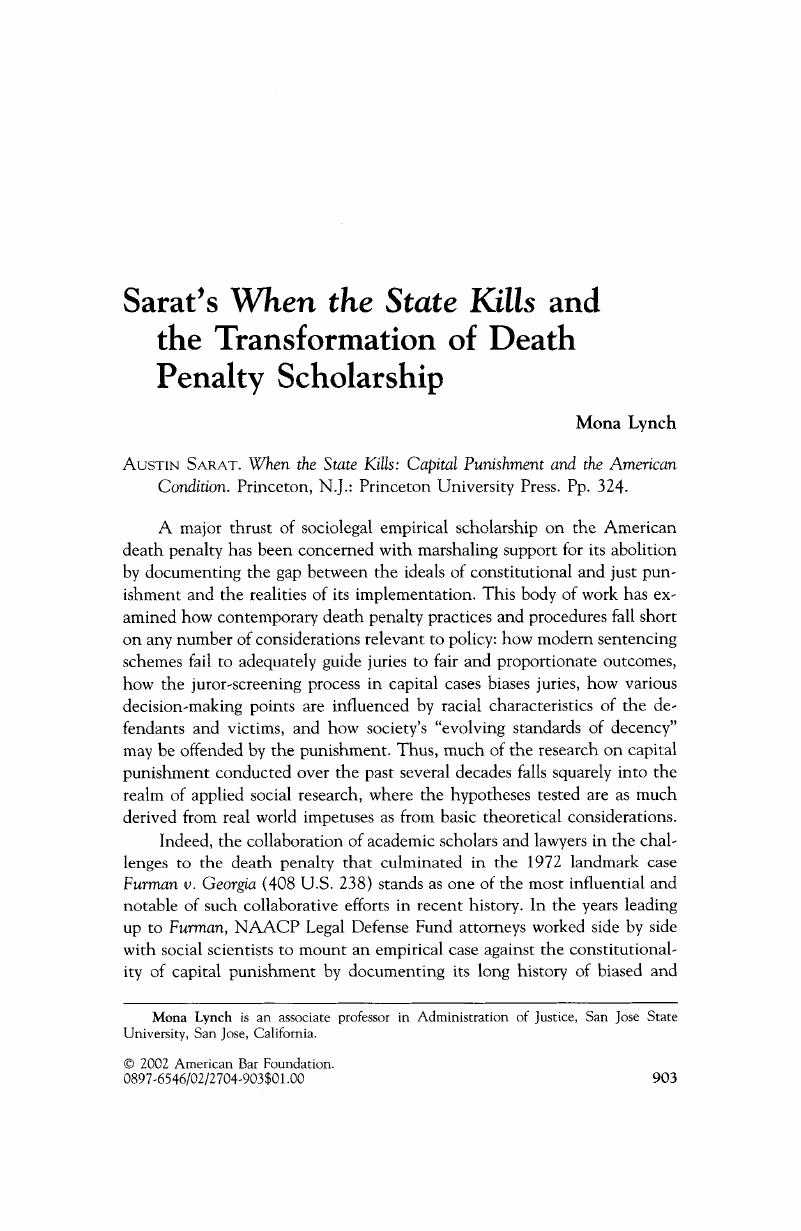No CrossRef data available.
Article contents
Sarat's When the State Kills and the Transformation of Death Penalty Scholarship
Published online by Cambridge University Press: 27 December 2018
Abstract
An abstract is not available for this content so a preview has been provided. Please use the Get access link above for information on how to access this content.

- Type
- Review Article
- Information
- Copyright
- Copyright © American Bar Foundation, 2002
References
Acker, James. 1993. A Different Agenda: The Supreme Court, Empirical Research Evidence, and Capital Punishment Decisions, 1986–1989. Law and Society Review
27: 65–88.Google Scholar
Axtman, Kris. 2002. US Milestone: 100th Death-Row Inmate Exonerated. Christian Science Monitor, 12 April, 1.Google Scholar
Baldus, David, Woodworth, George, and Pulaski, Charles. 1990. Equal Justice and the Death Penalty: A Legal Empirical Analysis. Boston: Northeastern University Press.Google Scholar
Banner, Stuart. 2002. The Death Penalty: An American History. Cambridge, Mass.: Harvard University Press.Google Scholar
Bowers, William, and Pierce, Glenn. 1980. Arbitrariness and Discrimination under Post-Furman Capital Statutes. Crime and Delinquency
26: 563–635.Google Scholar
Burt, Robert. 1987. Disorder in the Court: The Death Penalty and the Constitution. Michigan Law Review
85: 1741–1819.Google Scholar
Culbert, Jennifer. 1999. Beyond Intention: A Critique of the “Normal” Criminal Agency, Responsibility, and Punishment in American Death Penalty Jurisprudence. In The Killing State, ed. Sarat, Austin. New York: Oxford University Press.Google Scholar
Denno, Deborah. 1994. Is Electrocution an Unconstitutional Method of Execution? The Engineering of Death over the Century. William and Mary Law Review
35: 551–692.Google Scholar
Dieter, Richard. 1997. Millions Misspent: What Politicians Don't Say about the High Costs of the Death Penalty. In Death Penalty in America, ed. Adam Bedau, Hugo. New York, Oxford University Press.Google Scholar
Dwyer, Jim, Neufeld, Peter, and Scheck, Barry. 2000, Actual Innocence: Five Days to Execution and Other Dispatches from the Wrongly Convicted. New York: Doubleday.Google Scholar
Ellsworth, Phoebe, and Gross, Sam. 1994. Hardening of the Attitudes: Americans' Views on the Death Penalty. Journal of Social Issues
50: 19–52.Google Scholar
Fitzgerald, Robert, and Ellsworth, Phoebe. 1984. Due Process vs. Crime Control: Death Qualification and Jury Attitudes. Law and Human Behavior
8: 31–52.Google Scholar
Gross, Sam, and Mauro, Robert. 1989. Death and Discrimination: Racial Disparities in Capital Sentencing. Boston: Northeastern University Press.Google Scholar
Haney, Craig. 1984. On the Selection of Capital Juries: The Biasing Effects of Death Qualification. Law and Human Behavior
8: 121–132.Google Scholar
Haney, Craig. 1995. The Social Context of Capital Murder: Social Histories and the Logic of Mitigation. Santa Clara Law Review
35: 547–609.Google Scholar
Haney, Craig. 1997a. Commonsense Justice and Capital Punishment: Problematizing the “Will of the People. Psychology, Public Policy and Law
3: 303–37.Google Scholar
Haney, Craig. 1997b. Psychological Secrecy and the Death Penalty: Observations on the “Mere Extinguishment of Life. Studies in Law, Politics, and Society
16: 3–69.Google Scholar
Haney, Craig. 1997c. Violence and the Capital Jury: Mechanisms of Moral Disengagement and the Impulse to Condemn to Death. Stanford Law Review
49: 1447–86.Google Scholar
Haney, Craig, and Logan, Deanna. 1994. Broken Promise: The Supreme Court's Response to Social Science Research on Capital Punishment. Journal of Social Issues
50: 75–101.Google Scholar
Heberle, Renee. 2001. Law's Violence and the Challenge of “The Feminine. Studies in Law, Politics, and Society
22: 49–73.Google Scholar
Howarth, Joan. 1994. Deciding to Kill: Revealing the Gender in the Task Handed to Capital Jurors. Wisconsin Law Review
30: 1345–1424.Google Scholar
Huang, Allen. 1995. Hanging, Cyanide Gas, and the Evolving Standards of Decency: The Ninth Circuit's Misapplication of the Cruel and Unusual Clause of the Eighth Amendment. Oregon Law Review
74: 995–1029.Google Scholar
Kaufman-Osborn, Timothy. 2000. The Metaphysics of the Hangman. Studies in Law, Politics, and Society
20: 35–70.Google Scholar
Lynch, Mona. 2000a. The Disposal of Inmate #85271: Notes on a Routine Execution. Studies in Law, Politics, and Society
20: 3–34.Google Scholar
Lynch, Mona. 2000b. On-Line Executions: The Symbolic Use of the Electric Chair in Cyberspace. POLAR: Political and Legal Anthropology Review
23: 1–20.Google Scholar
Lynch, Mona. 2002. Capital Punishment as Moral Imperative: Pro-Death Penalty Discourse and Activism on the Internet. Punishment and Society
4: 213–36.Google Scholar
Masur, Louis. 1989. Rites of Execution: Capital Punishment and the Transformation of American Culture, 1776–1865. New York: Oxford University Press.Google Scholar
Meltsner, Michael. 1973. Cruel and Unusual: The Supreme Court and Capital Punishment. New York: Random House.Google Scholar
Neustadter, Roger. 1989. The “Deadly Current”: The Death Penalty in the Industrial Age. Journal of Popular Culture
12: 79–87.Google Scholar
Nolin, Robert. 1997. Simple Revenge Now Argument for Death Penalty. Arizona Republic, 5 October, A12.Google Scholar
Paternoster, Raymond. 1983. Race of Victim and Location of Crime: The Decision to Seek the Death Penalty in South Carolina. Journal of Criminal Law and Criminology
74: 754–85.Google Scholar
Sarat, Austin. 1993. Speaking of Death: Narratives of Violence in Capital Trials. Law and Society Review
27: 19–58.Google Scholar
Sarat, Austin. 1997. Vengeance, Victims and the Identities of Law. Social and Legal Studies
6: 163–89.Google Scholar
Sarat, Austin, and Vidmar, Neil. 1976. Public Opinion, the Death Penalty and the Eighth Amendment: Testing the Marshall Hypothesis. Wisconsin Law Review
17: 171–206.Google Scholar
Steiner, Benjamin. Forthcoming. Narratives of the Death Sentence: The Tale of Racial Inferiority and African Resistance: Towards a Theory of Legal Narrativity. Law and Society Review 35.Google Scholar
Steiner, Benjamin, Bowers, William, and Sarat, Austin. 1999. Folk Knowledge as Legal Action: Death Penalty Judgments and the Tenet of Early Release in a Culture of Mistrust and Punitiveness. Law and Society Review
33: 461–505.Google Scholar
Thompson, William. 1989. Death Qualification after Wainwright v. Witt and Lockhart v. McCree. Law and Human Behavior
13: 185–215.Google Scholar
Weisberg, Robert. 1996. The New York Statute as Cultural Document: Seeking the Morally Optimal Death Penalty. Buffalo Law Review
44: 283–302.Google Scholar
Zeisel, Hans. 1981. Race Bias in the Administration of the Death Penalty: The Florida Experience. Harvard Law Review
95: 456–68.Google Scholar
Zimring, Franklin. 1993. On the Liberating Virtues of Irrelevance. Law and Society Review
27: 9–17.Google Scholar
Zimring, Franklin, and Hawkins, Gordon. 1986. Capital Punishment and the American Agenda. New York: Cambridge University Press.Google Scholar




